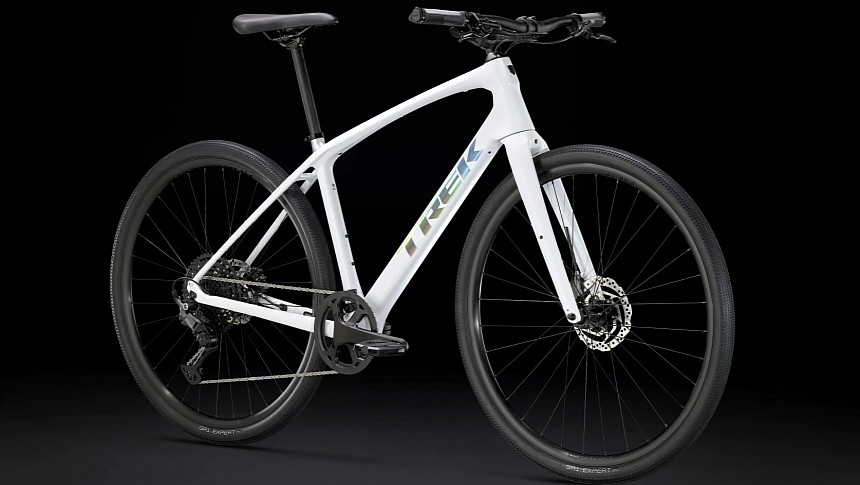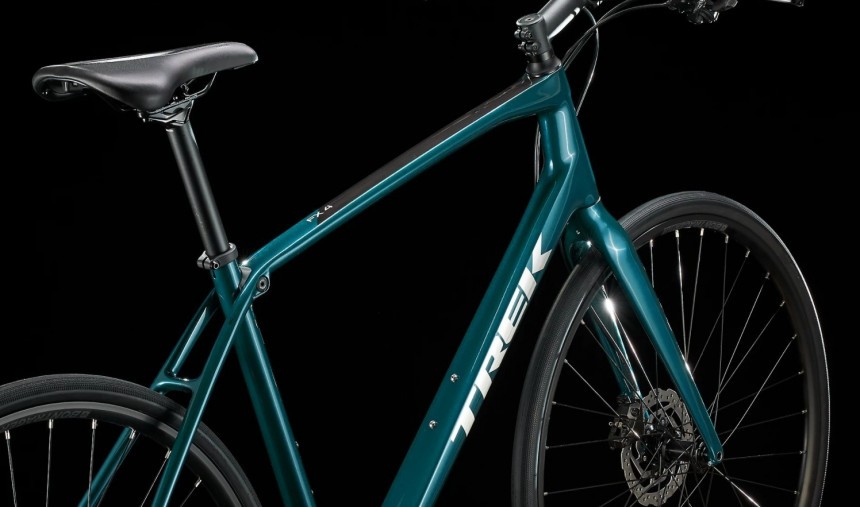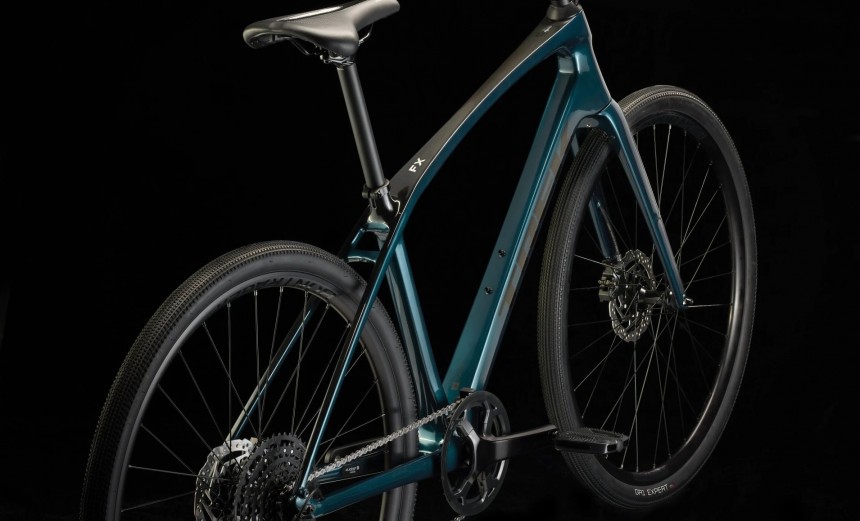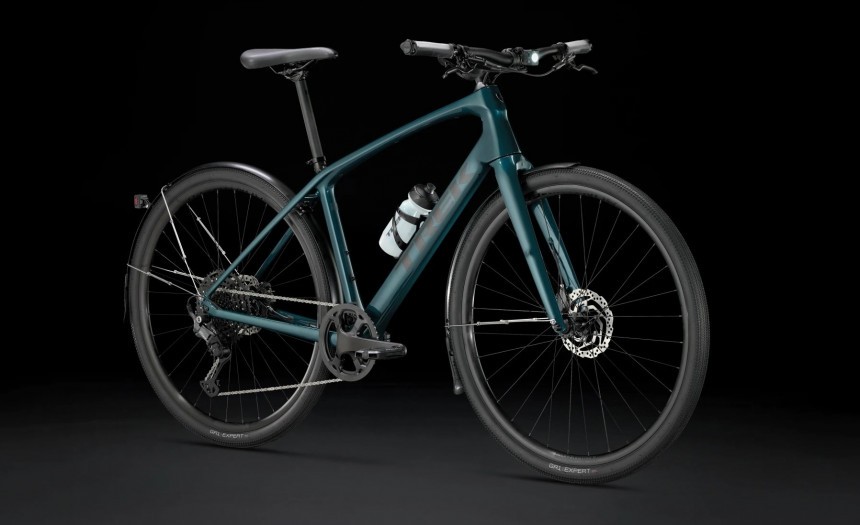Just how little can a carbon fiber bicycle cost us? This is the question Trek's latest FX Sport 4 is answering. Oh, and just to cut to the case here, $1,800 is all you need to get your hands on this luscious hunk of composite.
Yes, $1,800 (€1,643 at current exchange rates) is all that Trek is asking folks like you and me to drop on their latest iteration of the FX Sport. If this lineup sounds familiar, it may be because we've covered it before, particularly back in 2021, when I first got word of Trek's new goal.
Well, that was then, and now, Trek is back with an updated and more modernized version. Yet, some clear differences exist, so let's dive deeper into all that is the new FX Sport 4.
As I mentioned, Trek used nothing more than carbon fiber to craft this bike. For this feat, 400 Series OCLV Carbon was used. With it, smooth and juicy tubes all run fluidly into one another along the way, putting pressure in all the right places and ensuring a responsive, fast, and calorie-burning experience. After all, the FX Sport lineup is part of Trek's fitness class of bikes.
Now, one major difference between this version and the previous one is the IsoSpeed; the new FX Sport 4 does NOT have this feature in place. Suppose you don't know what IsoSpeed is. In that case, it's one of Trek's ingenious ways of adding suspension properties to an otherwise rigid road bike.
They achieved this by pulling the seat tube away from the top tube to create a bit of wiggle room. As a result, when we hit a bump in the road, the seat tube flexes just a tad, absorbing some of the hit in the process. Best of all, this system is designed to achieve all this without affecting the level of power directed into your cranks and wheels. IsoSpeed, you will be missed.
Come to think of it, Trek probably realized that your average rider doesn't need IsoSpeed, at least not on a bicycle that's meant to help you burn calories. Then again, all that carbon should be more than enough to reduce vibrational transfer into your body.
Furthermore, Trek infused this bike with tech and geometry similar to gravel and road bikes. In short, it's an amalgam of styles, which is actually a good thing for the newer rider. By imbuing the FX Sport 4 with wide tires, a rigid front fork, a flat bar cockpit, 1X drivetrain, and a "sporty" geometry, Trek created a Frankenstein, one that can handle asphalt, gravel, limestone, and even some light dirt roads, all in the same ride.
This mix of riding styles wrapped up into one neat package has yet another benefit. The FX Sport can be taken out to achieve that burn we talked about. Still, it's also a go-to solution for riding to work and coming home, and even grabbing some groceries. When the weekend rolls around, it can serve as your beast of burden, carrying countless bits of cargo and utensils. The latter is essential if you're into bike-packing or camping out on the edge of town.
While the main triangle can accommodate a cargo bag and two water bottle cages, the front fork opens up to your cargo-carrying needs with mounts. At the rear, only fender mounts seem to be available, but I'm sure you can figure out a way to fully utilize this section of the bike, too.
Now, I personally enjoy what Trek has achieved here, especially if we consider that it's all carbon fiber, but a tradeoff does exist, and we can find it in most of the secondary gear added to the Sport 4. For example, we're looking at Prowheel cranks and a Shimano Cues drivetrain, the lower-budget stuff.
For everything else, there's Bontrager, supplying the rims, tires, stem, and handlebar, among others. However, with a tad more cash, you can easily upgrade a few key components, like that drivetrain, and if you really want to go wild, drop a gravel suspension fork onto your FX Sport and create something else. You may want to look into a more comfortable saddle, too.
Put all this into an affordable, light, and speedy package, and what do we have? Some riders would say we have a solid contender for your next do-it-all machine. After all, it can handle asphalt, gravel, and light dirt roads, all the while carrying cargo or your groceries. Other riders may be looking at their first and last bicycle, and there are plenty of reasons why that is.
At the end of the day, as we move forward in time, space, and technology, we're sure to see more and more carbon fiber machines hitting the market, and surely at lower and lower prices. This begs the question, just how cheap can a carbon fiber bicycle be? It seems like Trek is on a quest to find out, and it's great news for us.
Well, that was then, and now, Trek is back with an updated and more modernized version. Yet, some clear differences exist, so let's dive deeper into all that is the new FX Sport 4.
As I mentioned, Trek used nothing more than carbon fiber to craft this bike. For this feat, 400 Series OCLV Carbon was used. With it, smooth and juicy tubes all run fluidly into one another along the way, putting pressure in all the right places and ensuring a responsive, fast, and calorie-burning experience. After all, the FX Sport lineup is part of Trek's fitness class of bikes.
Now, one major difference between this version and the previous one is the IsoSpeed; the new FX Sport 4 does NOT have this feature in place. Suppose you don't know what IsoSpeed is. In that case, it's one of Trek's ingenious ways of adding suspension properties to an otherwise rigid road bike.
Come to think of it, Trek probably realized that your average rider doesn't need IsoSpeed, at least not on a bicycle that's meant to help you burn calories. Then again, all that carbon should be more than enough to reduce vibrational transfer into your body.
Furthermore, Trek infused this bike with tech and geometry similar to gravel and road bikes. In short, it's an amalgam of styles, which is actually a good thing for the newer rider. By imbuing the FX Sport 4 with wide tires, a rigid front fork, a flat bar cockpit, 1X drivetrain, and a "sporty" geometry, Trek created a Frankenstein, one that can handle asphalt, gravel, limestone, and even some light dirt roads, all in the same ride.
While the main triangle can accommodate a cargo bag and two water bottle cages, the front fork opens up to your cargo-carrying needs with mounts. At the rear, only fender mounts seem to be available, but I'm sure you can figure out a way to fully utilize this section of the bike, too.
Now, I personally enjoy what Trek has achieved here, especially if we consider that it's all carbon fiber, but a tradeoff does exist, and we can find it in most of the secondary gear added to the Sport 4. For example, we're looking at Prowheel cranks and a Shimano Cues drivetrain, the lower-budget stuff.
Put all this into an affordable, light, and speedy package, and what do we have? Some riders would say we have a solid contender for your next do-it-all machine. After all, it can handle asphalt, gravel, and light dirt roads, all the while carrying cargo or your groceries. Other riders may be looking at their first and last bicycle, and there are plenty of reasons why that is.
At the end of the day, as we move forward in time, space, and technology, we're sure to see more and more carbon fiber machines hitting the market, and surely at lower and lower prices. This begs the question, just how cheap can a carbon fiber bicycle be? It seems like Trek is on a quest to find out, and it's great news for us.

















